Treat yourself to massages, body treatments, Nordic baths and other sensory delights.


THINGS TO DO
Your Townships adventure starts here.
Spa & Wellness
Treat yourself to massages, body treatments, Nordic baths and other sensory delights.
Arts, Culture & Heritage
Let your imagination run free at galleries, theatres, museums and workshops.
Shopping
Scour our markets, boutiques and other hidden gems to score incredible finds.
Restaurants
All are sure to please even the most discerning of palates. Bon appétit!
Events
Discover our cultural vitality with a wide range of special events.
Skiing
To each mountain its experience! Skiing or snowboarding, you will love hitting the slopes, whichever the ski resort you will vote for!
Snowshoeing
Explore our great outdoor spaces at your own beat. Let yourself be charmed by our landscapes. And breathe!
Cross-country Skiing
Cross-country skiing in the Townships … at your pace and your level!
Fatbike
Discover our numerous trails as you enjoy pedalling on the snow.
Where to stay
Lodging options to suit any taste and budget.
Hotels & Country Inns
Stunning locations and outstanding service come together for a bliss-inducing stay.
Bed & Breakfasts
Get up close and personal with life in the Townships.
Off the Beaten Path
Think outside the box with out of the ordinary accommodations.
Cottages & Condos
Custom comfort near the city or in nature.
Campgrounds
Abundant amenities in the heart of nature.
Vacation Centres
Kick back and relax as a family with all-inclusive vacation options.
Other Types of Lodging
Experience something different by choosing unique lodging.
Lodgings with Spa Options
Plan a stay in an accommodation with a private spa or a treatment center. Relaxation guaranteed!
Hikers Welcome
If you, like thousands of visitors annually, plan on hiking in the region, know that your efforts will be rewarded by our world-class hospitality.
Pet Friendly
Don’t want to leave your four-legged friend behind? Book a stay in some of the region’s many dog-friendly digs and you won’t have to.
The Townships
The Townships possess a rich heritage that you will discover everywhere on its nine territories, in its towns and villages, its Coeurs villageois, etc.
Not to be missed
What is it that draws visitors to the region, year after year? Find out here :
Cœurs villageois
Visit our Cœurs villageois – charming communities that truly characterize the spirit of our region.
Towns and villages
Explore our lively, welcoming towns and villages with their heritage architecture and fascinating histories.
Nine territories to discover
Each territory has a distinct personality and a wealth of hidden treasures just waiting to be discovered!
The Townships at a glance
Here’s a glimpse of the region, a few historical notions, and numbers.
Tourist routes
Hit the road! The region has several tourist routes designed around different themes – heritage, scenic landscapes, wine….
National and regional parks
Four national and two regional parks – an outdoor paradise in the fresh air, each and every one!
Taste the townships
Here, in so many ways, you’ll enjoy all kinds of gastronomical experiences! When you discover our unique products and our highly renowned tables, you’ll love us forever!
Restaurants
Every time you sit down at one of our tables, you’ll experience a truly special moment. Savour it!
Cafés de village
Visit our Cafés de Village and discover each one’s specialties while meeting the most welcoming and friendly people.
Créateurs de Saveurs Products
You can rely on our food producers who put as much love as delicious flavours into everything they plant and produce.
Vineyards
The Route des vins de Brome-Missisquoi, the Route des vins de l’Estrie, and about twenty other vineyards… The Townships region proudly honours its title of being the first wine region of Quebec.
Microbreweries
The region counts more than twenty microbreweries! Just like the people who run them, each one has established their own strong, unique personality and … extremely inviting character!
Cheese Factories & Dairy Producers
goat’s milk… Here you’ll savour rich artisanal cheeses. Some you already know, many others you’ll enjoy discovering.
Sugar shacks
Enjoy a traditional meal and maple taffy on snow.
Restaurants Saveurs Cantons-de-l’Est
These restaurants prioritize local producers and offer dishes made with regional ingredients, providing an authentic experience of the Eastern Township terroir.
Foodie’s Maps
Brasseurs des Cantons and Têtes fromagères are two gastronomical circuits highlighting our microbreweries and cheese factories.
Gourmet Itineraries
Plan your stay by offering yourself a wealth of flavours. Consult our getaway ideas.
Weekend and Trip Ideas
Discover our activities suggestions, getaway ideas and itineraries in the Townships.
Family Outings
Find loads of ideas for memorable family outings!
Romantic Getaways
Outings, restaurants, spas, weekend ideas… Suggestions for spending some precious moments together.
Outdoor Activities
Snowshoeing, skiing, fatbiking, tube sliding... Without a doubt, all outdoor enthusiasts are sure to find something to do here!
Wellness Experiences and Spas
Let us help you take care of yourself.
Itineraries
Whether for two, with your family or with friends, here you will find a ton of suggestions for planning perfect getaways!
Blogs and articles
Our collaborators have tested several different adventures … and have approved!
Townships Ambassadors
Meet inspiring locals, discover their favourite spots and get their best insider tips!
Coeur villageois
Visit our Cœurs villageois – charming communities that truly characterize the spirit of our region.
Towns and Villages
Explore our lively, welcoming towns and villages with their heritage architecture and fascinating histories.
Guide and Maps
View our guide and maps online or order your free copies.
Updated on Apr 3, 2024
While there were once more than 1,000 covered bridges built throughout Québec, there are now less than a hundred in the entire province, 15 of which can be found in the Eastern Townships. These fascinating structures bear witness to our past, and constitute important elements of the region’s built heritage. Let’s take a look at our 15 covered bridges that continue to stand the test of time.
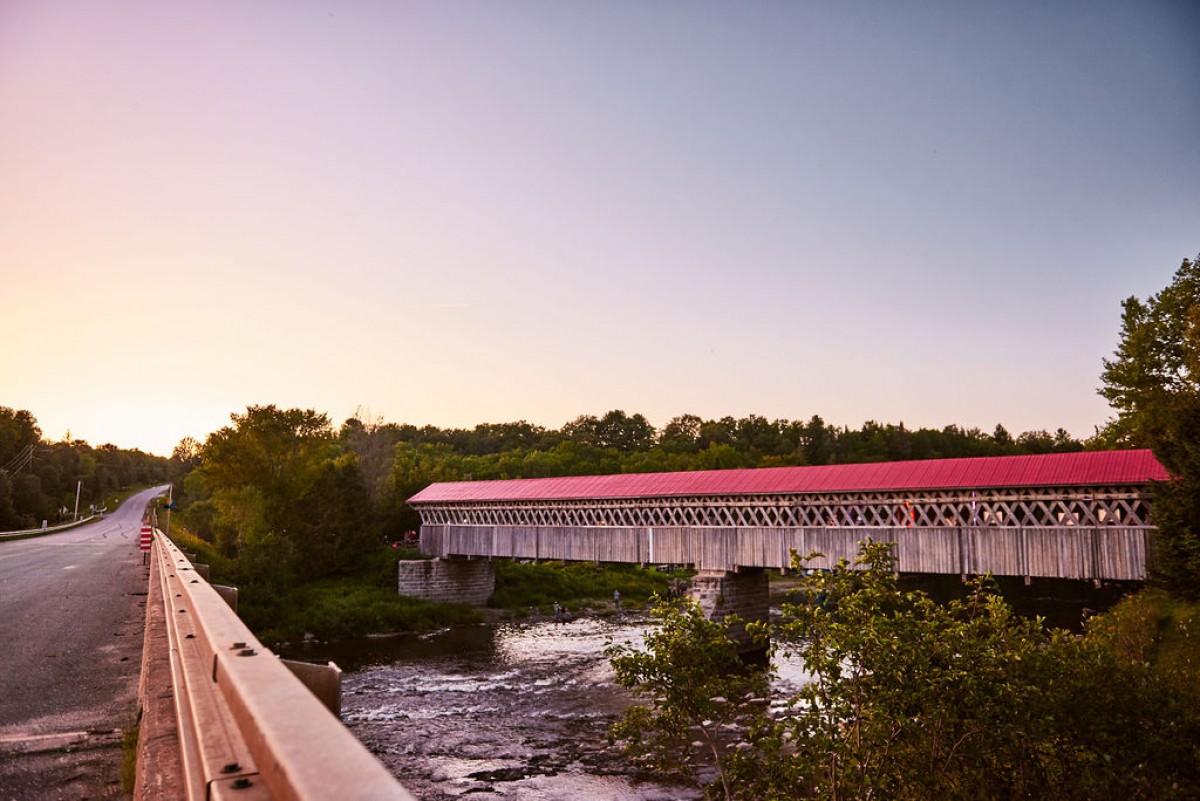
Measuring almost 63 m, it’s the longest covered bridge of the Eastern Townships. Before the pandemic it served as the venue for the La nuit du pont couvert festival held every year during the month of August.
Location: 151 Route 257, Lingwick
Year built: 1893
Still in use: No
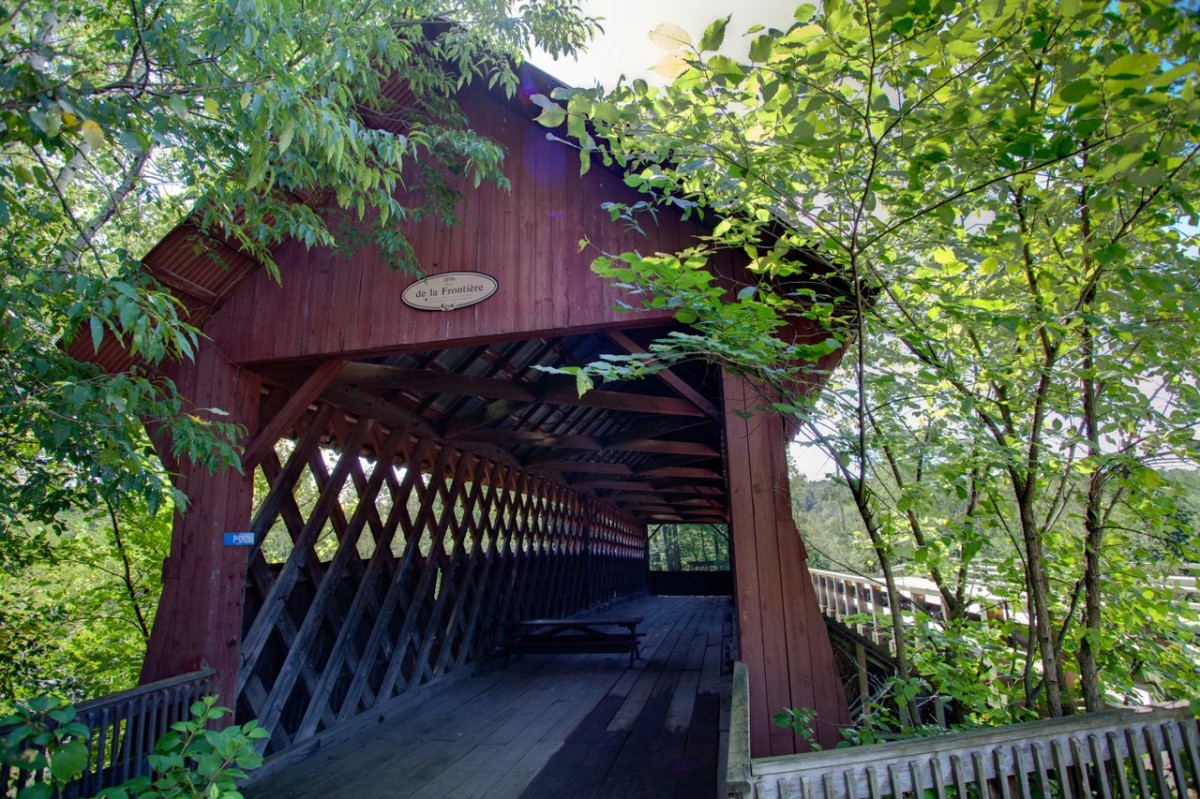
Also called Province Hill, this bridge is located nearby the Canada-US border and was designated a heritage building in 2008.
Location: 5 Covered Bridge Road, Mansonville (Canton de Potton)
Year built: 1896
Still in use: No
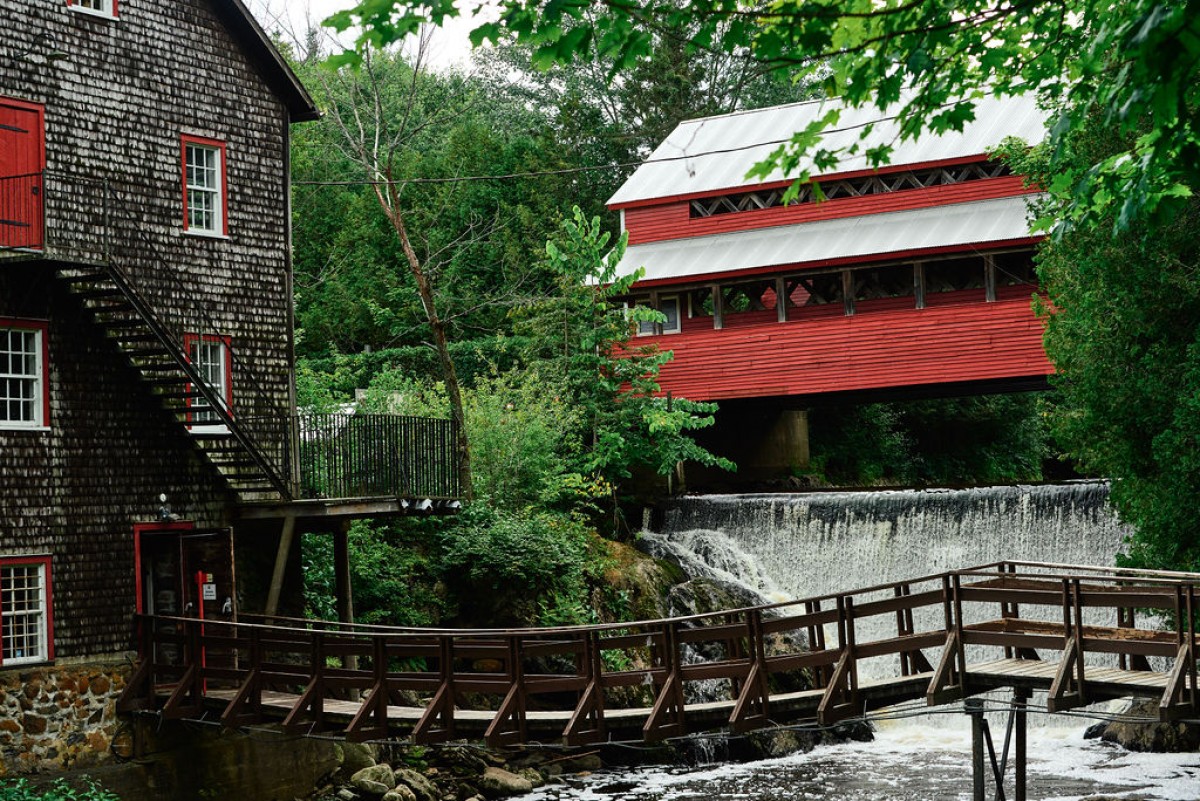
An integral part of the Ulverton Wool Mill landscape, this bridge is one of the most recently constructed in the area. In fact, it was named after the man who contributed to its restoration and reconstruction. Interestingly, and rather rarely in Québec, a covered footbridge runs alongside the bridge.
Location: 210 Porter Road, Ulverton
Year built: 1994. This is a replica of the original bridge built in 1885.
Still in operation: Yes
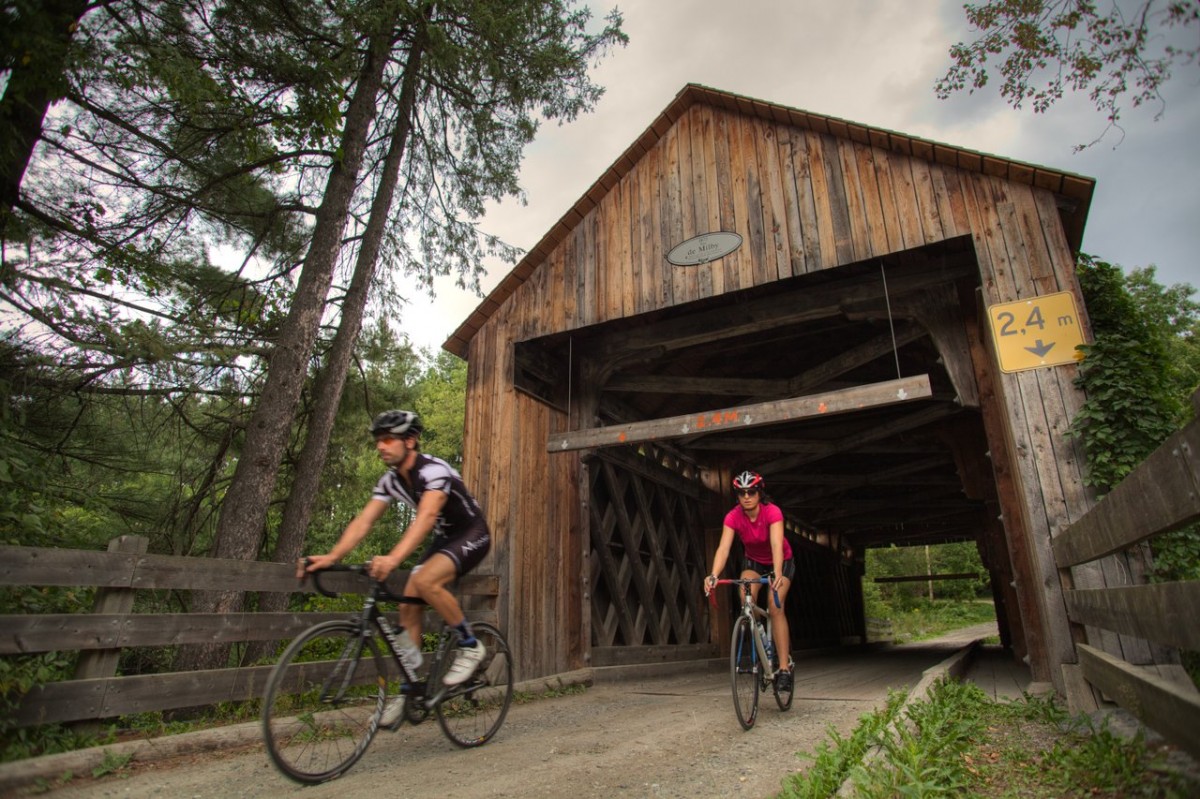
Designated as a heritage building in 1992, the Milby covered bridge has some unusual features for a bridge of this type, including a roof made of cedar shingles instead of metal. It also serves as the entrance to the Camping du Pont couvert.
Location: Chemin du Pont-Couvert, Milby (Waterville)
Year built: 1873
Still in use: Yes, but only in the summer.
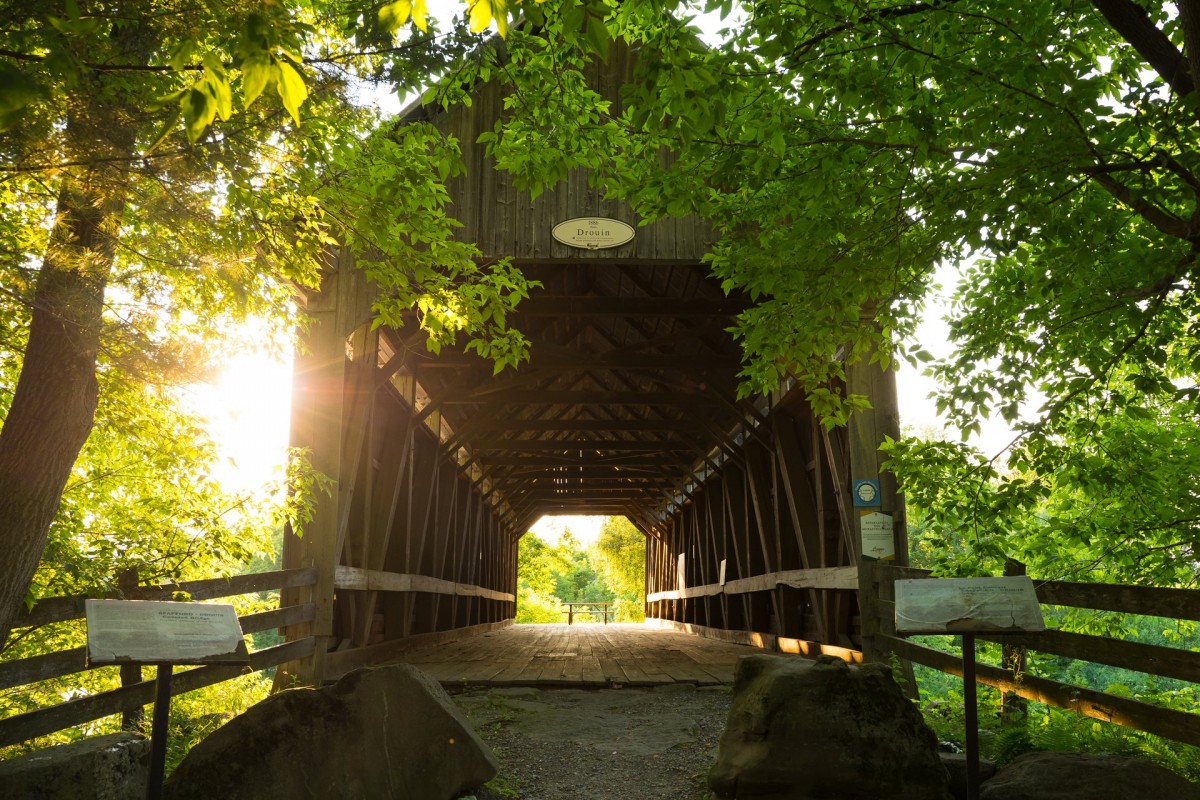
A landing near the bridge for small boats (kayak, canoe, paddleboard) will allow you to admire the bridge from the Coaticook River.
Location: Chemin Drouin, Compton
Year of construction: 1886
Still in use: No
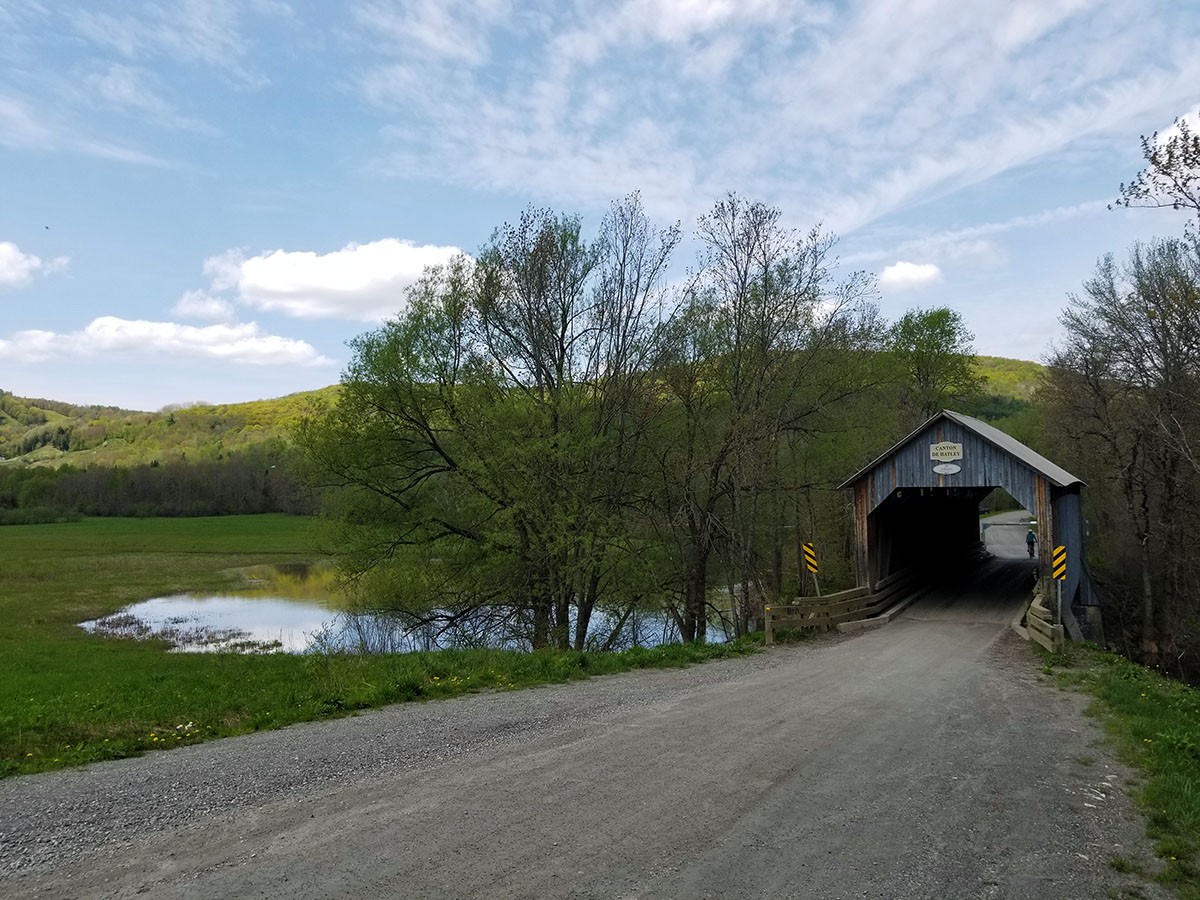
It’s been restored several times, and was even completely closed for a few years, but today it welcomes travellers once again and is one of the remnants of the former mining town of Eustis.
Location: Chemin Astbury, Waterville
Year of construction: 1908
Still in use: Yes, but only in the summer.
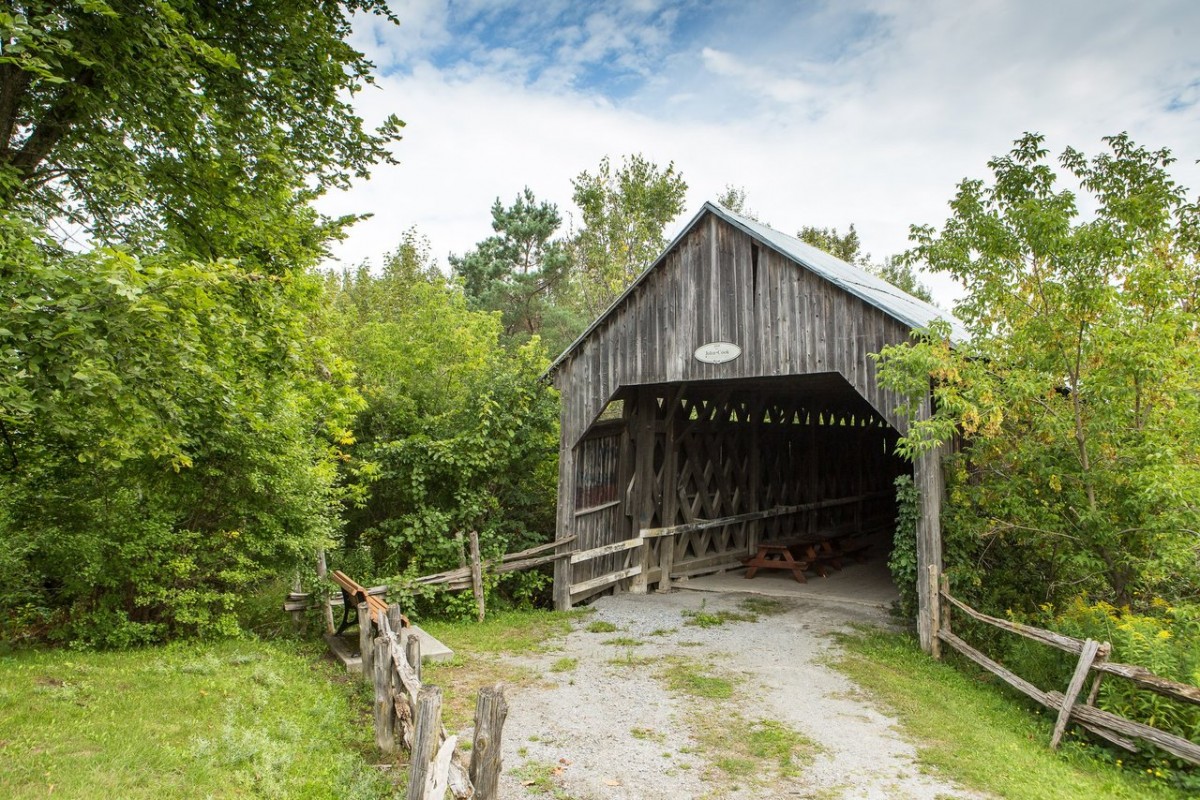
It’s the oldest covered bridge in the Eastern Townships. It was named after John Cook, one of the first settlers of Cookshire-Eaton.
Location: Craig Street North, Cookshire-Eaton
Year built: 1868
Still in use: No
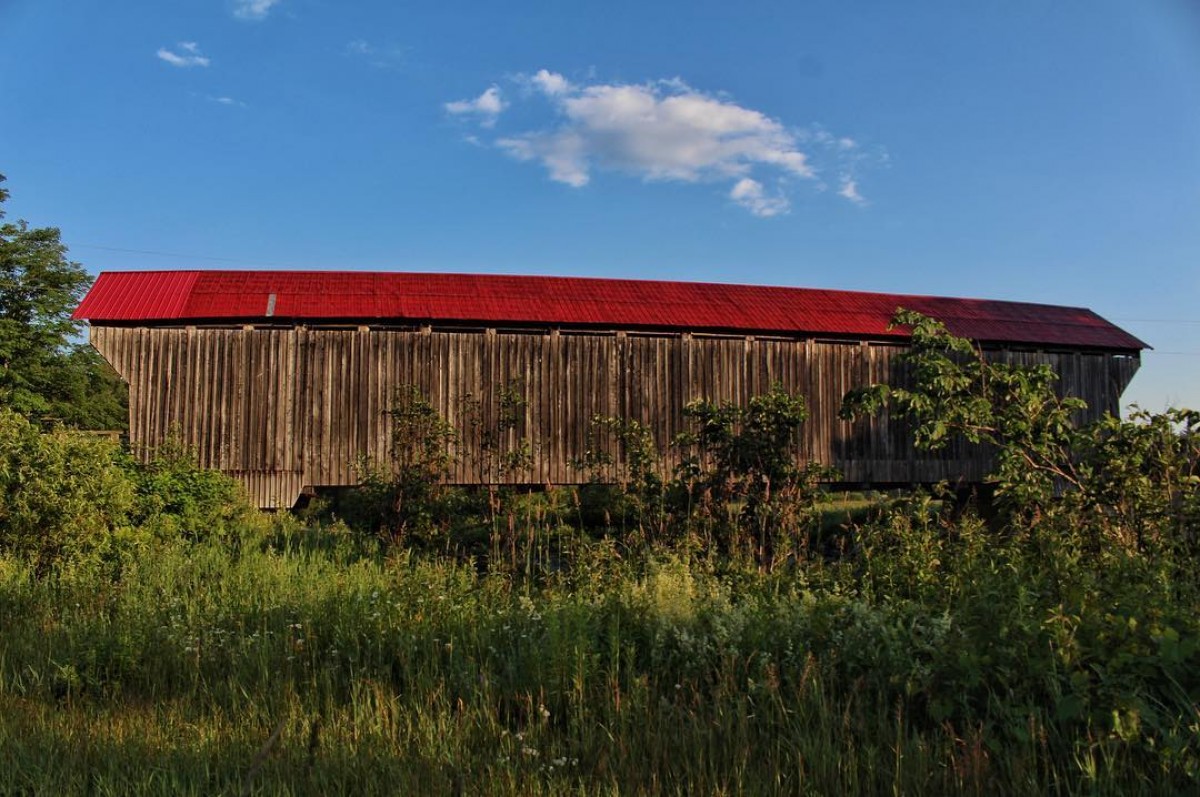
The roots of a tree were used to carve out some of the structural elements of this bridge. A feature you will also find on the Eustis Bridge.
Location: McDermott Road, Cookshire-Eaton
Year built: 1886
Still in use: Yes
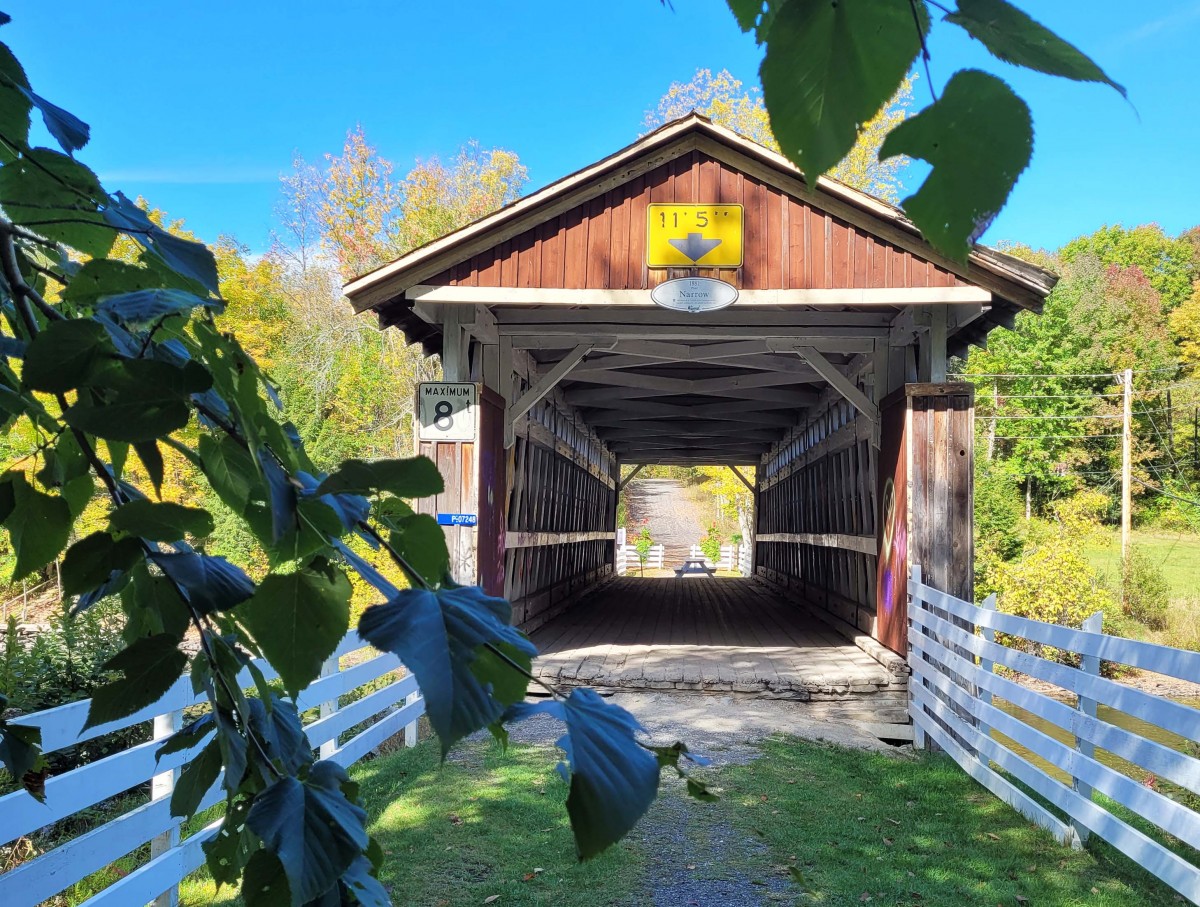
The name of this bridge comes from the fact that it spans the narrowest part of Fitch Bay on Lake Memphremagog. It’s one of the few covered bridges built over a lake rather than a river.
Location: 685 Narrows Road, Stanstead
Year built: 1881
Still in use: No
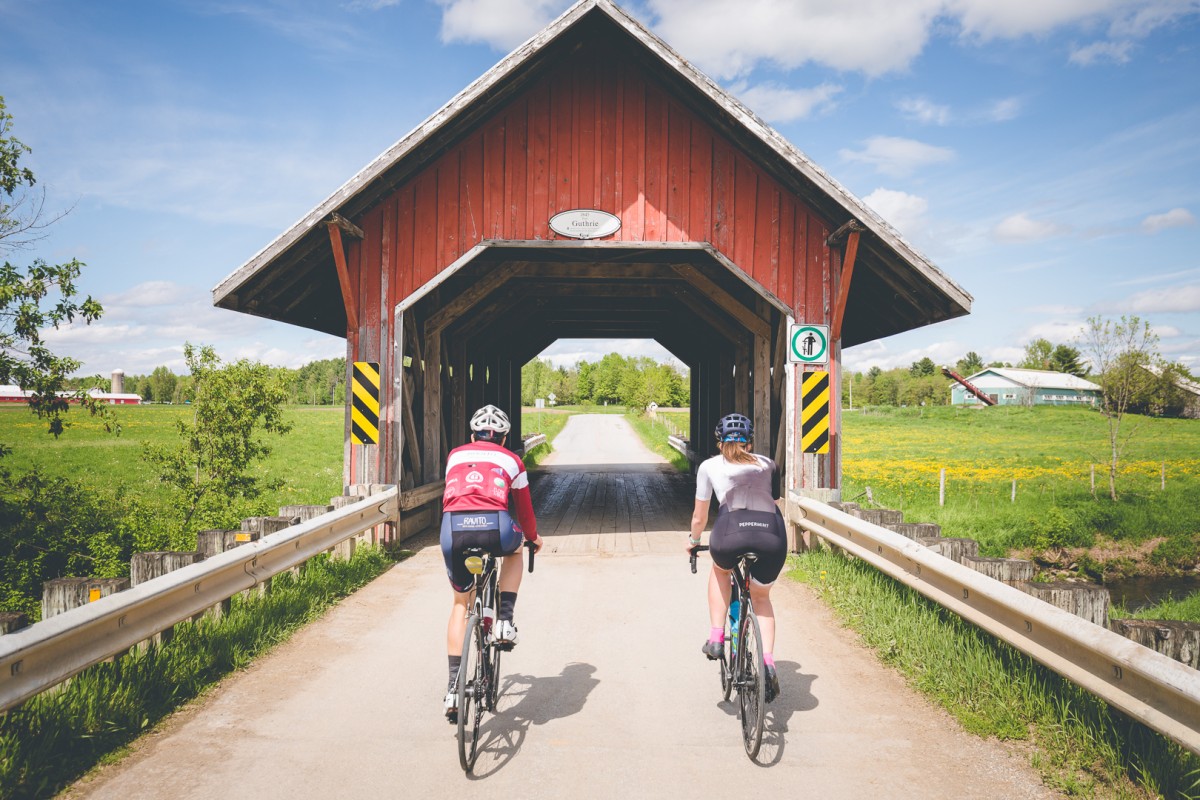
The last remaining bridge in a series of four similar bridges built in the Saint-Armand area, this covered bridge is also the shortest in Québec measuring almost 15 m in length.
Location: Chemin Edoin, Saint-Armand
Year of construction: Although the date of construction of this bridge is posted as 1845, the current bridge dates back to 1888.
Still in use: Yes
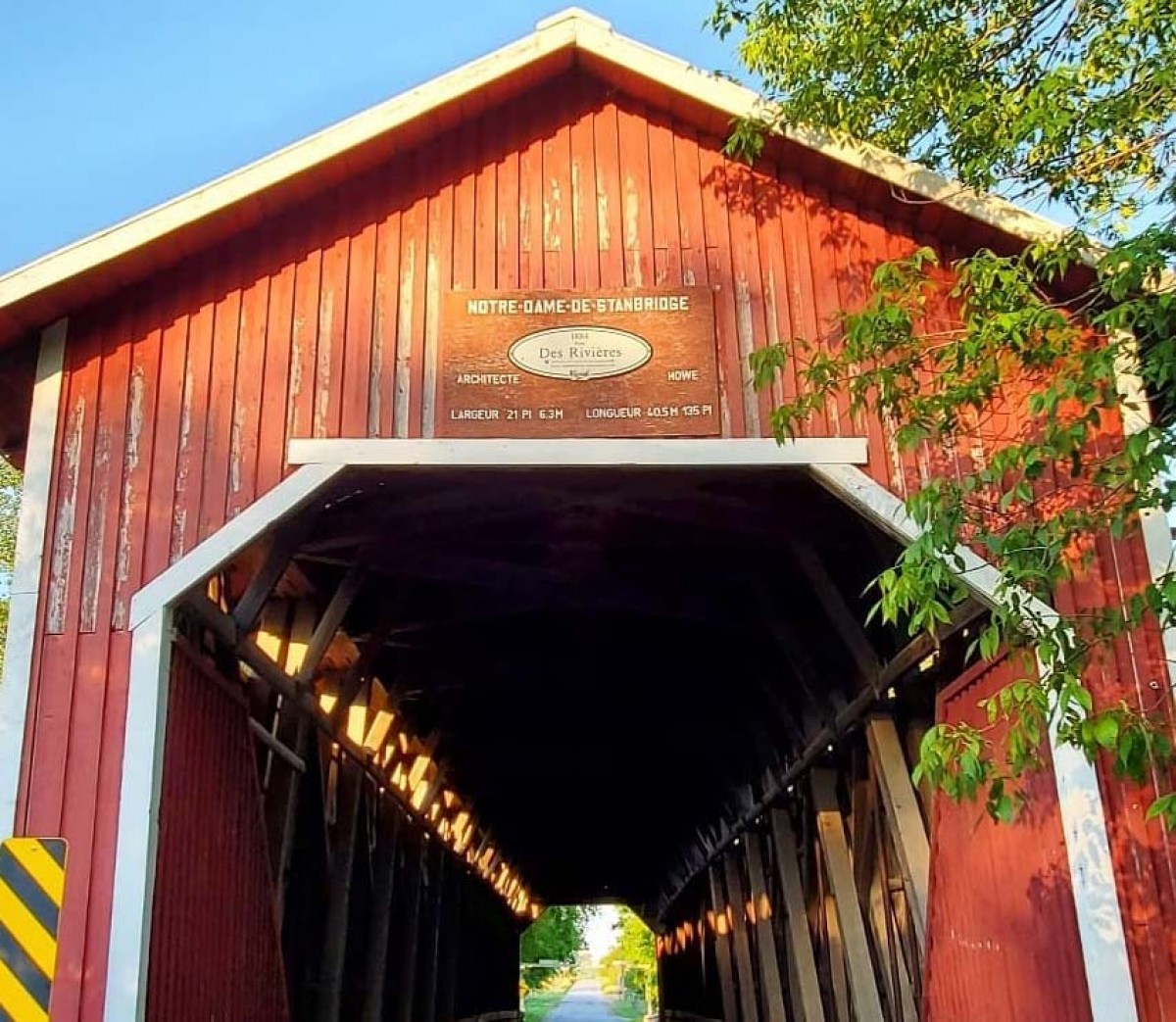
It’s the last remaining Howe truss bridge (a construction method involving the addition of adjustable steel tension rods in the structure) in Québec. Few bridges were built using this technology because of its complexity.
Location: Chemin Saint-Charles, Notre-Dame-de-Stanbridge
Year of construction: 1884
Still in use: Yes
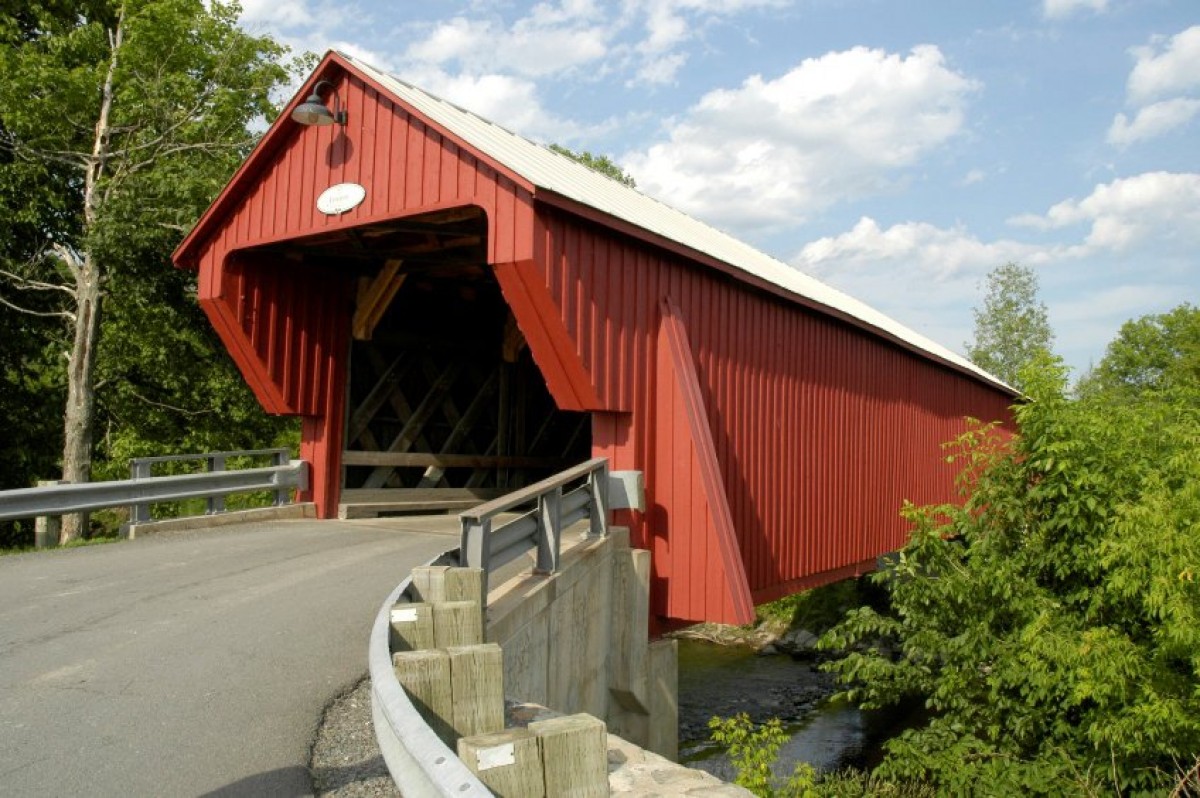
The architecture of the entrance portal is one of the distinguishing features of this covered bridge spanning the South Yamaska River. Over the years, it has undergone numerous repairs, notably following truck accidents and fires.
Location: Bell St., Cowansville
Year of construction: 1870
Still in use: Yes
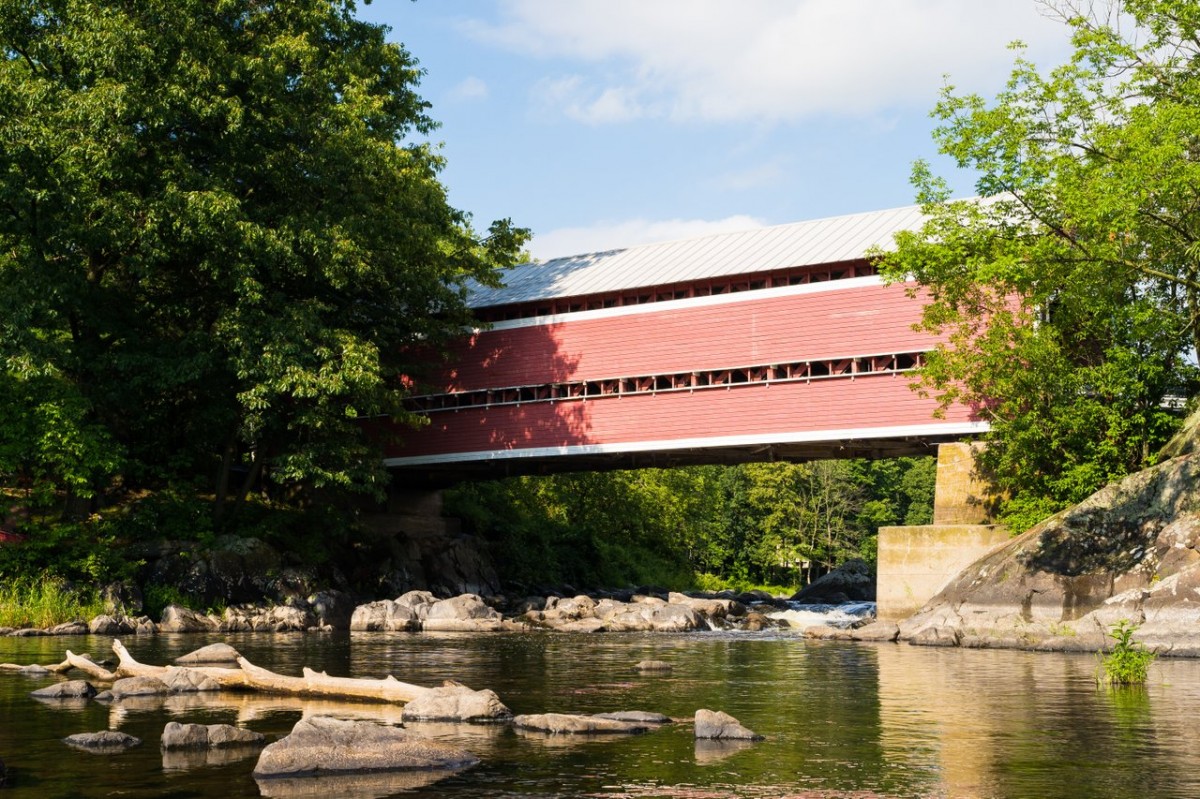
An amusing fact: in the 1980s, this bridge was showcased in a Sico paint advertisement and in the process, it received a major makeover!
Location: Chemin Léger, Brigham
Year of construction: 1932
Still in use: Yes
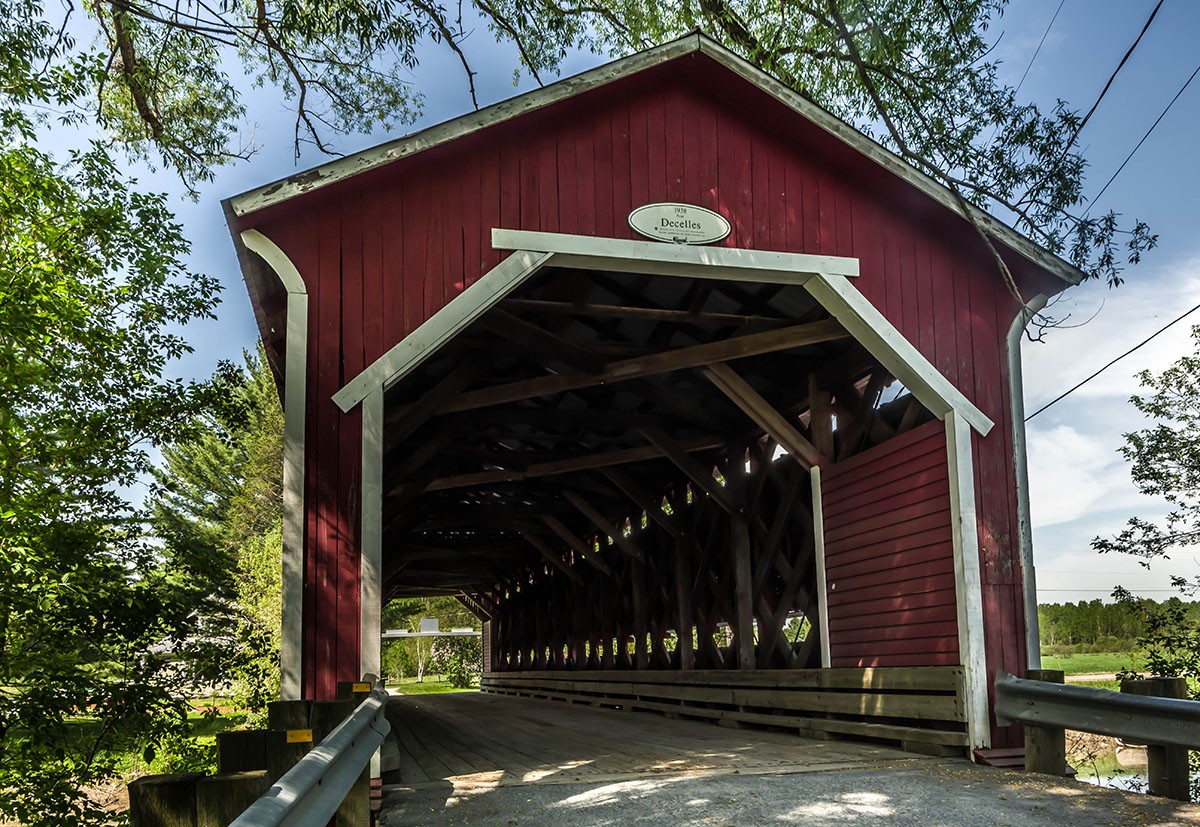
Regularly threatened by spring flooding, this second covered bridge in Brigham was raised in 2007 to preserve its use. Like the Balthazar Bridge, it spans the Yamaska River.
Location: Fortin St., Brigham
Year of construction: 1938
Still in use: Yes
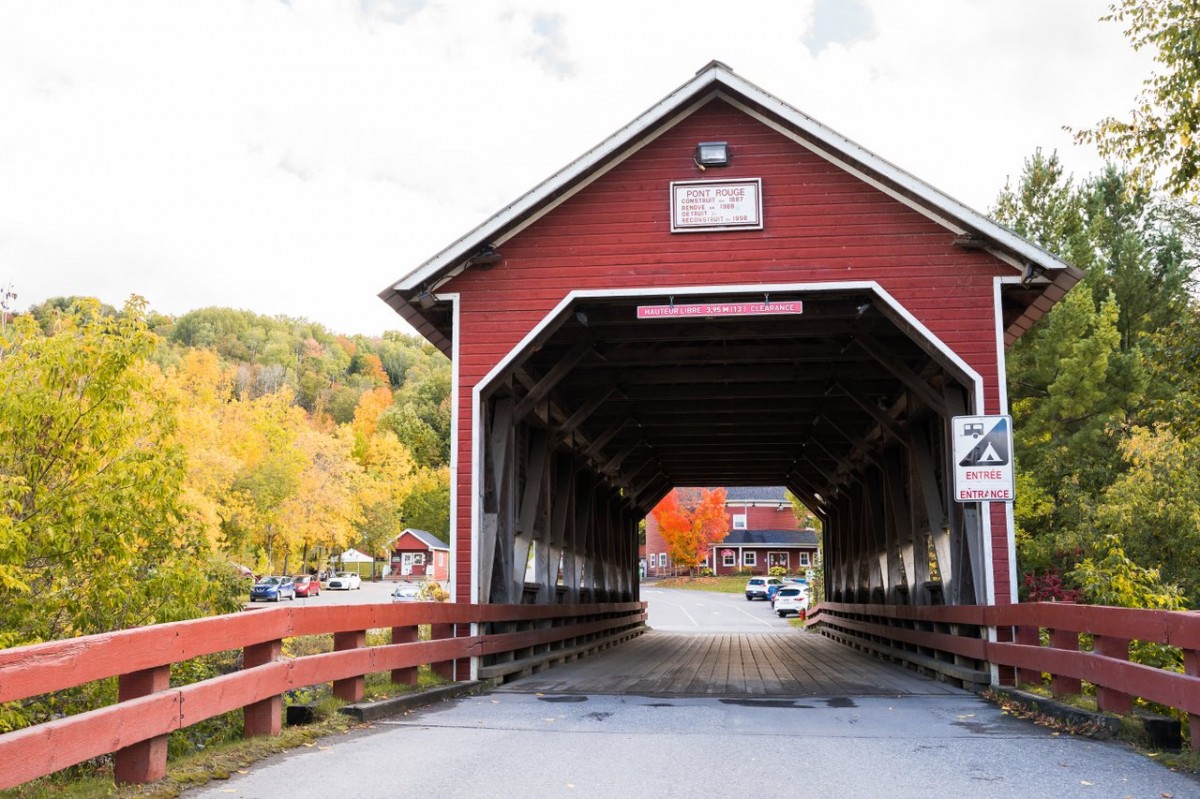
Although it’s not considered as an authentic covered bridge, Coaticook’s Pont Rouge is still worth a look! Since it’s located at the entrance to the Parc de la Gorge de Coaticook, take this opportunity to explore the park, which also has the longest pedestrian suspension bridge in North America.
Location: Saint-Marc St., Coaticook
Year of construction: 1998. Originally built in 1887.
Still in use: Yes
Closely linked to the colonization and the development of our roads, the history of covered bridges in Québec extends over more than 135 years of services. Although these bridges appear to be quite similar at first glance, they do, however, feature different construction techniques and offer several characteristics that make them stand out from each other. A fact you’ll be able to confirm on your tour of the covered bridges of the Eastern Townships!
In order to protect the wooden bridges against harsh weather conditions and therefore to prevent them from rotting, the decision was made to cover them. Putting a roof on a bridge increased the life span of the structure tenfold, which otherwise would be limited to about 15 years.
The colour red would have been used to paint these bridges in order for them to stand out from the green summer landscapes and the white winter landscapes. Added to this, the range of colours available at the time was limited and the red pigment and linseed oil mixture used at the time was inexpensive.
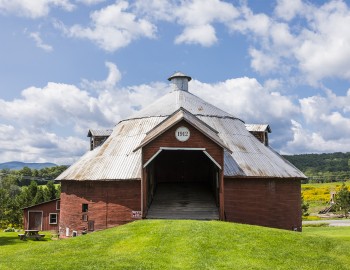
Arts, culture and heritage
The Round Barns of the Southern Townships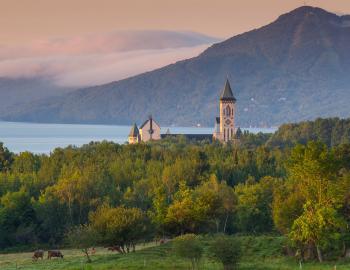
Arts, culture and heritage
The Top 7 Most Beautiful Religious Sites in the Eastern Townships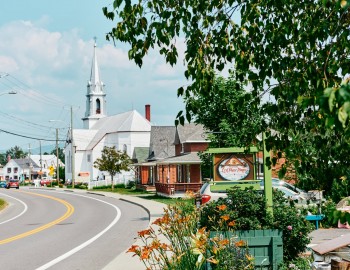
Arts, culture and heritage
The Coeurs villageois in video
Filters
X






